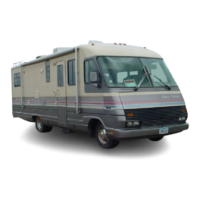23
Discovery, Discovery LXE, Pace Arrow, and Pace Arrow LXEt
Towing Systems
Hitch Receiver:
Tongue weight must not
exceed 10% of the rated capacity
when using the hitch receiver.
The ratings associated with the
particular hitch receiver supplied
with the motorhome are noted on
the federal certication weight
label and on the weight label
afxed to the hitch receiver.
The weight label on the hitch
receiver provides the maximum
trailer weight rating and the
maximum tongue weight rating. It
is important that these ratings not
be exceeded.
It is important that towing
devices attached to the hitch
receiver are rated equal to or
greater than the load of a towed
trailer, automobile dolly, or other
towed load.
Consult with your dealer or
towing equipment/trailer supplier
to determine the correct type of
hitch head assembly, hitch ball and
other towing equipment for a safe
and correctly assembled towing
system for the towed load.
Towing literature is also
available from vehicle
manufacturers, the National
Highway trafc Safety
Administration, towing equipment
manufacturers, trade associations,
and publications/books about how
to tow.
Ball Mount:
Ball mounts come in various
congurations and weight
limitations. There are three things
to consider when selecting a ball
mount: weight rating, pin to ball
center length and rise/drop. The
weight rating of the ball mount,
tongue weight and tow weight
must meet or exceed the total load
weight.
Pin to ball center should not
exceed 8". Ball mounts of longer
length will signicantly reduce
the weight rating of the hitch
receiver. Observe weight
reduction percentages that may
be listed on ball mounts longer
than 8".
Selecting how much rise or
drop a ball mount will need is
relative to hitch receiver height
and height of the towed load with
respect to the type of towing
equipment between the motorhome
and towed load. When connected,
the towed load or towing
equipment should be level and
parallel with the ball mount.
Weight Distributing Hitches:
A weight-distributing hitch
(load-equalizing) uses spring
bars attached to the trailer tongue
A-frame assembly to transfer some
of the trailer tongue weight to both
motor home axles.
A weight-carrying hitch (ball
mount) assembly does not use
spring bars. All of the tongue
weight of the trailer bears down
on the hitch assembly that loads
the motorhome rear axle(s). For
this reason, the maximum load
is limited when using only a ball
mount.
In addition to ball mounts and
weight-distributing, the hitch may
also have a tow car rating. This
rating will apply should a motor
vehicle be towed with all four
wheels down.
A major weight distributing
hitch manufacturer provides
the following information in
their installation and operation
instructions:
“…Severe bumps and badly
undulating road can damage your
towing vehicle, hitch, and trailer,
and should be negotiated at a slow
steady speed.”
Distance from the
top of the shank to
the top of the hitch
ball platform.
020314
Distance from the
center of the hitch
ball hole to the center
of the pin hole.
Distance from the
shank to the top of
the hitch ball platform.
8”
090512g
Weight distributing hitch
Spring Bars
Weight Distributing
Head Assembly
090539
Hitch receiver
Weight Label

